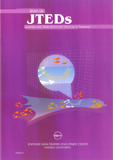Study on Juvenile and Trash Excluder Devices (JTEDs) in Thailand
抄録
SEAFDEC Training Department, in cooperation with the Thai Department of Fisheries has initially conducted the experiments on Juvenile and Trash Excluder Device (JTED) since 1998 in Thailand. The objective being to study the catching and releasing efficiency for juvenile and trash fishes using different escape opening in JTEDs. 2 types of JTEDs namely rectangular shape and semi-curve JTEDs with 8 different escape opening were designed and each was tested for 9 replications.
CPUEs of fish trawl net operated in Chumporn and Prachub Kirikan Areas were 21.2 and 13.4 kg/hr, about 50% and 30% of these catches were represented with commercial fish species, respectively. Percentage of escapement of commercial fishes, by weight, of trawl net attached with the rectangular shape and semi-curve JTEDs with different escape openings did not obtain significantly selectivity of the JTEDs. However, the percentage of escape, by numbers, of juvenile and young commercial fishes show clearly that the percentage of escape using Semi-curve JTEDs is 7 times higher than that of the Rectangular JTEDs. In addition, to the trash fishes about 50% were released when using the Semi-curve JTEDs.
Improvements in JTED design is needed for more selective JTEDs in increase the catching and escape efficiency for commercial juvenile/young and trash fishes.
Citation
Chokesanguan, B., Ananpongsuk, S., Siriraksophon, S., & Podapol, L. (2000). Study on juvenile and trash excluder devices (JTEDs) in Thailand. Samut Prakan, Thailand: Training Department, Southeast Asian Fisheries Development Center.

